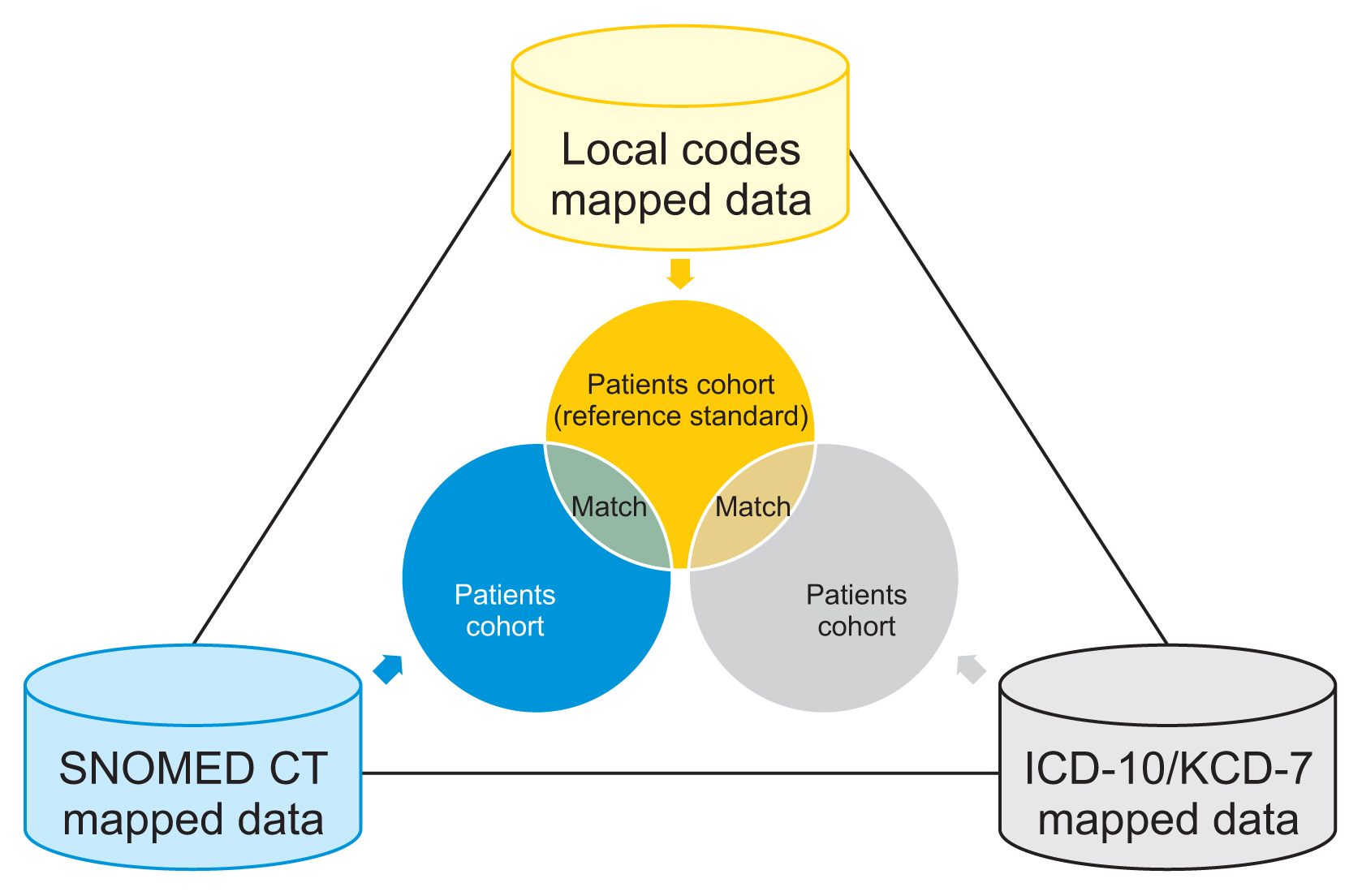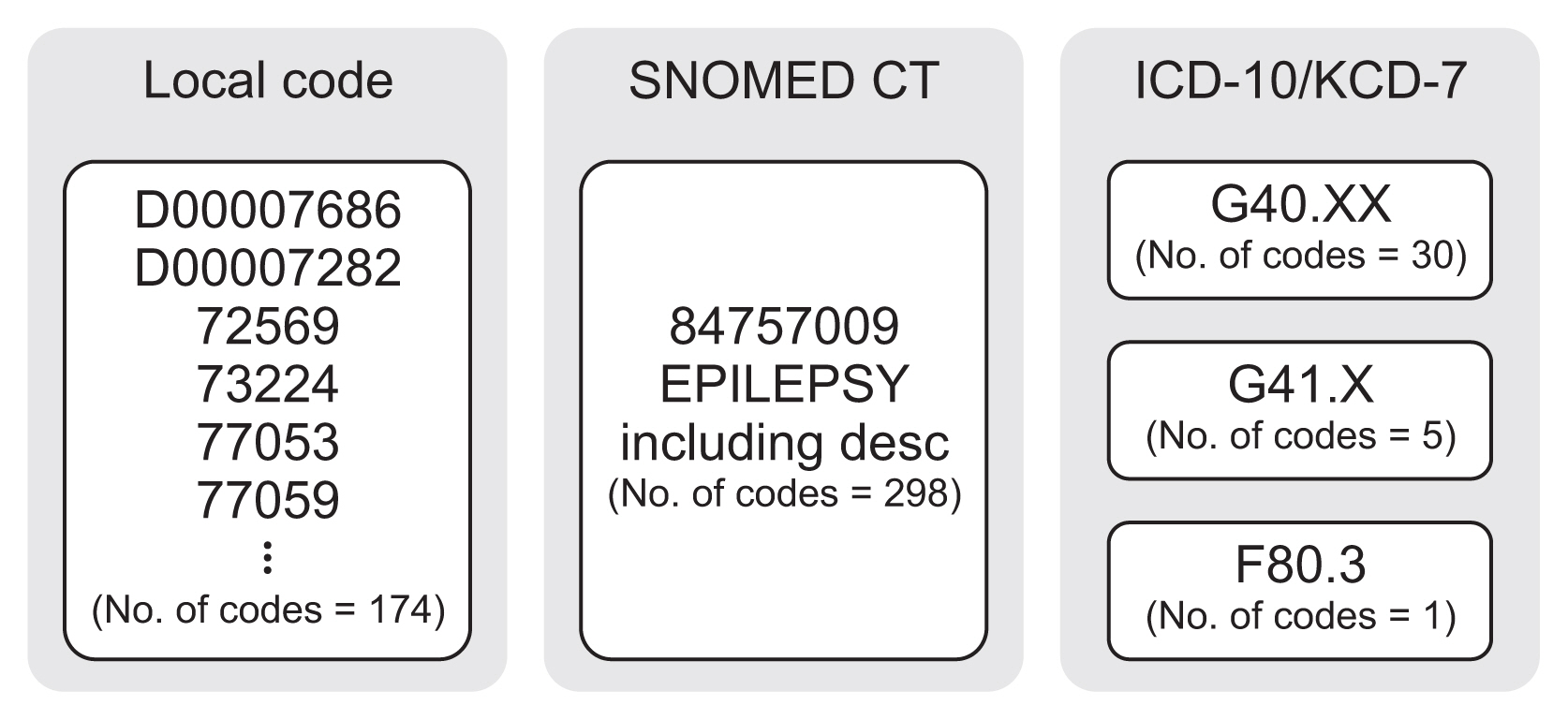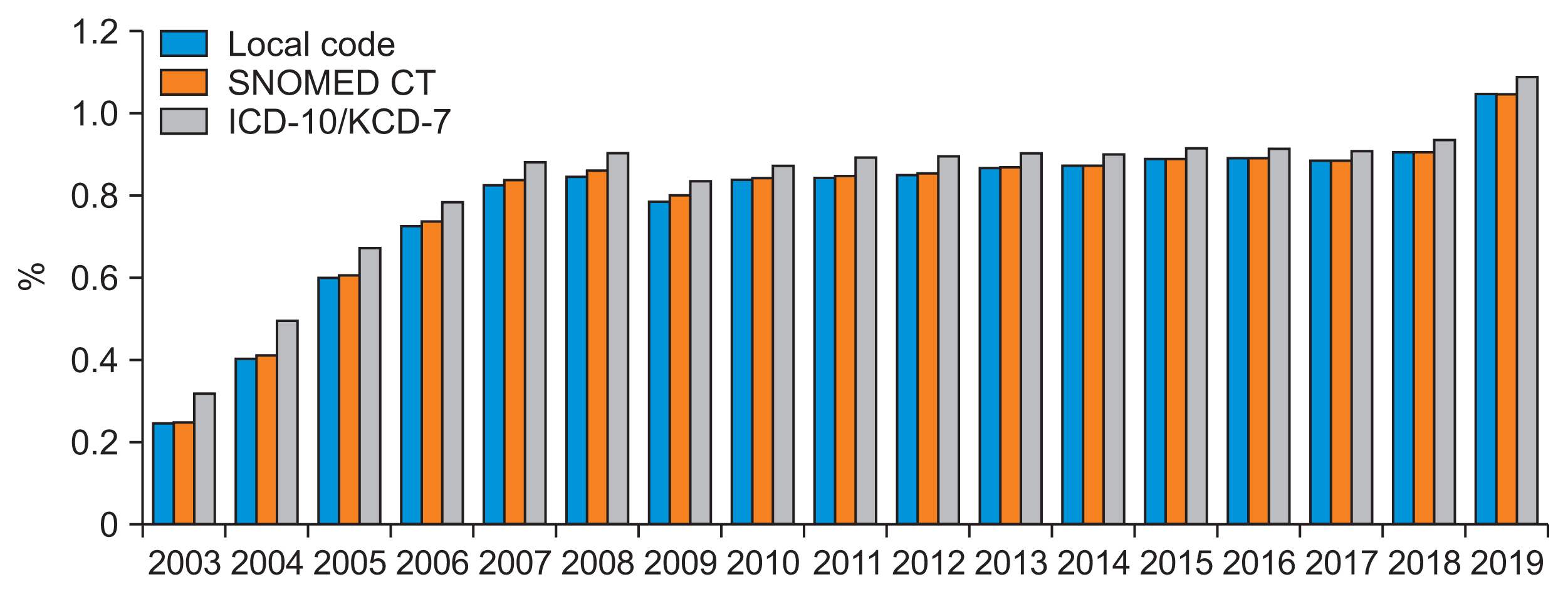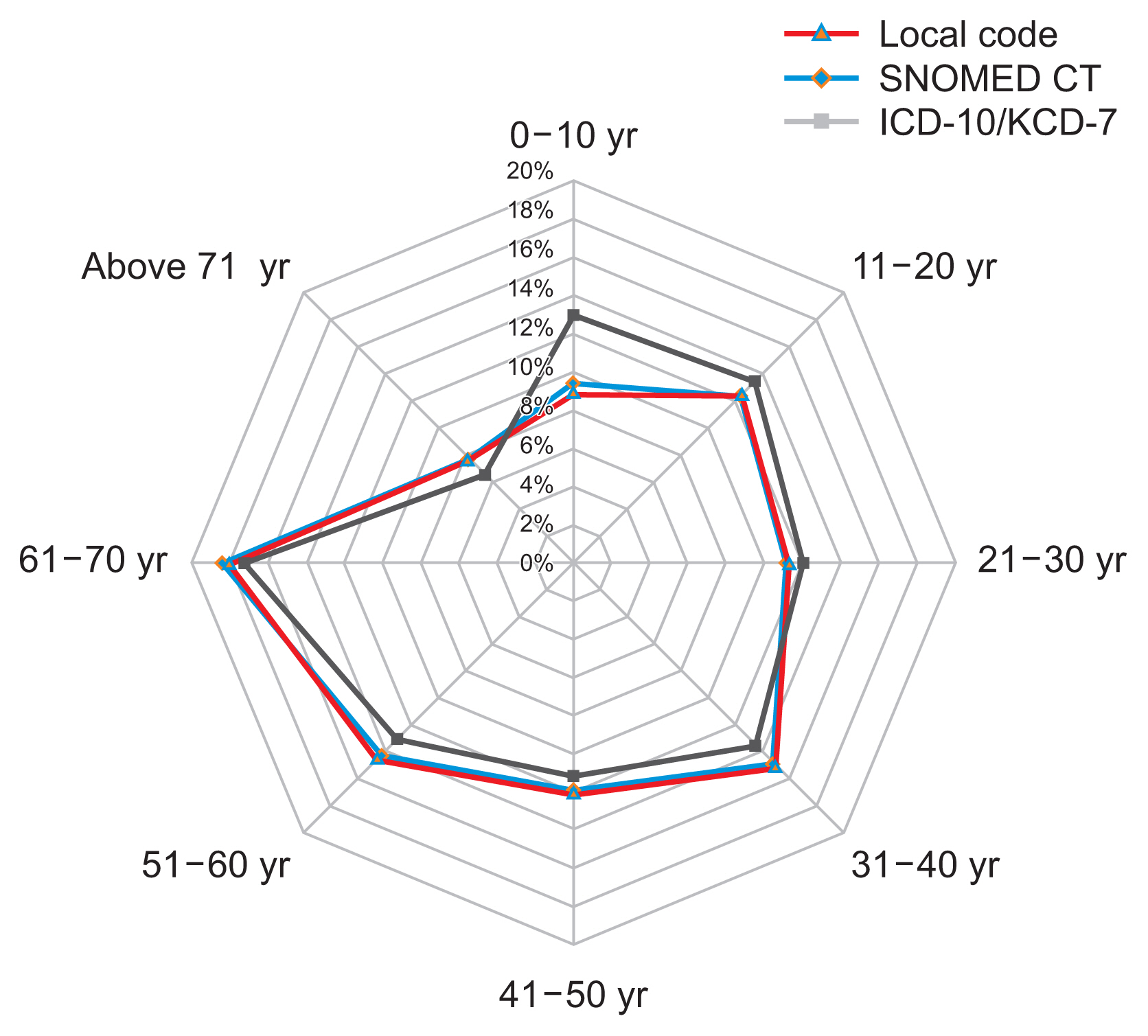Healthc Inform Res.
2022 Jul;28(3):240-246. 10.4258/hir.2022.28.3.240.
Effectiveness of the Use of Standardized Vocabularies on Epilepsy Patient Cohort Generation
- Affiliations
-
- 1Healthcare ICT Research Center, Seoul National University Bundang Hospital, Seongnam, Korea
- 2Department of Nuclear Medicine, Seoul National University Bundang Hospital, Seongnam, Korea
- 3Kakao Healthcare Company-In-Company, Seongnam, Korea
- KMID: 2532451
- DOI: http://doi.org/10.4258/hir.2022.28.3.240
Abstract
Objectives
This study investigated the effectiveness of using standardized vocabularies to generate epilepsy patient cohorts with local medical codes, SNOMED Clinical Terms (SNOMED CT), and International Classification of Diseases tenth revision (ICD-10)/Korean Classification of Diseases-7 (KCD-7).
Methods
We compared the granularity between SNOMED CT and ICD-10 for epilepsy by counting the number of SNOMED CT concepts mapped to one ICD-10 code. Next, we created epilepsy patient cohorts by selecting all patients who had at least one code included in the concept sets defined using each vocabulary. We set patient cohorts generated by local codes as the reference to evaluate the patient cohorts generated using SNOMED CT and ICD-10/KCD-7. We compared the number of patients, the prevalence of epilepsy, and the age distribution between patient cohorts by year.
Results
In terms of the cohort size, the match rate with the reference cohort was approximately 99.2% for SNOMED CT and 94.0% for ICD-10/KDC7. From 2010 to 2019, the mean prevalence of epilepsy defined using the local codes, SNOMED CT, and ICD-10/KCD-7 was 0.889%, 0.891% and 0.923%, respectively. The age distribution of epilepsy patients showed no significant difference between the cohorts defined using local codes or SNOMED CT, but the ICD-9/KCD-7-generated cohort showed a substantial gap in the age distribution of patients with epilepsy compared to the cohort generated using the local codes.
Conclusions
The number and age distribution of patients were substantially different from the reference when we used ICD-10/KCD-7 codes, but not when we used SNOMED CT concepts. Therefore, SNOMED CT is more suitable for representing clinical ideas and conducting clinical studies than ICD-10/KCD-7.
Keyword
Figure
Reference
-
References
1. SNOMED International. Members [Internet]. London, UK: SNOMED International;c2022. [cited at 2022 Jun 30]. Available from: https://www.snomed.org/our-stakeholders/members.2. Park HA, Yu SJ, Jung H. Strategies for adopting and implementing SNOMED CT in Korea. Healthc Inform Res. 2021; 27(1):3–10. https://doi.org/10.4258/hir.2021.27.1.3.
Article3. Hripcsak G, Levine ME, Shang N, Ryan PB. Effect of vocabulary mapping for conditions on phenotype cohorts. J Am Med Inform Assoc. 2018; 25(12):1618–25. https://doi.org/10.1093/jamia/ocy124.
Article4. Reich C, Ryan PB, Stang PE, Rocca M. Evaluation of alternative standardized terminologies for medical conditions within a network of observational healthcare databases. J Biomed Inform. 2012; 45(4):689–96. https://doi.org/10.1016/j.jbi.2012.05.002.
Article5. Observational Health Data Sciences and Informatics. The book of OHDSI [Internet]. [place unknown]: Observational Health Data Sciences and Informatics;2021. [cited at 2022 Jun 30]. Available from: https://ohdsi.github.io/TheBookOfOhdsi/.6. Papez V, Moinat M, Payralbe S, Asselbergs FW, Lumbers RT, Hemingway H, et al. Transforming and evaluating electronic health record disease phenotyping algorithms using the OMOP common data model: a case study in heart failure. JAMIA Open. 2021. 4(3):ooab001fc. https://doi.org/10.1093/jamiaopen/ooab001.
Article7. Hripcsak G, Shang N, Peissig PL, Rasmussen LV, Liu C, Benoit B, et al. Facilitating phenotype transfer using a common data model. J Biomed Inform. 2019; 96:103253. https://doi.org/10.1016/j.jbi.2019.103253.
Article8. SNOMED International. SNOMED CT to ICD-10 mapping technical guide [Internet]. London, UK: SNOMED International;c2020. [cited at 2022 Jun 30]. Available from: http://snomed.org/icd10map.9. Kim H, Yoo S, Jeon Y, Yi S, Kim S, Choi SA, et al. Characterization of anti-seizure medication treatment pathways in pediatric epilepsy using the electronic health record-based common data model. Front Neurol. 2020; 11:409. https://doi.org/10.3389/fneur.2020.00409.
Article10. Jette N, Beghi E, Hesdorffer D, Moshe SL, Zuberi SM, Medina MT, et al. ICD coding for epilepsy: past, present, and future: a report by the International League Against Epilepsy Task Force on ICD codes in epilepsy. Epilepsia. 2015; 56(3):348–55. https://doi.org/10.1111/epi.12895.
Article11. Cimino JJ. Desiderata for controlled medical vocabularies in the twenty-first century. Methods Inf Med. 1998; 37(4–5):394–403. https://doi.org/10.1055/s-0038-1634558.
Article12. Helwig A. EHR certification criteria for SNOMED CT will help doctors transition to ICD-10 [Internet]. Washington (DC): Office of the National Coordinator for Health Information Technology (ONC);2013. [cited at 2022 Jun 30]. Available from: https://www.healthit.gov/buzz-blog/electronic-health-and-medical-records/ehrcertification-criteria-snomed-ct-doctors-transitionicd10.13. eMERGE Network Epilepsy/antiepileptic drug response algorithm [Internet]. Nashville (TN): Vanderbilt University;c2017. [cited at 2022 Jun 30]. Available from: https://phekb.org/phenotype/epilepsyantiepilepticdrug-response-algorithm.






